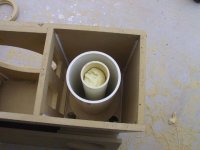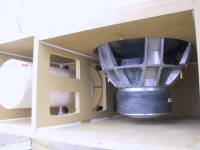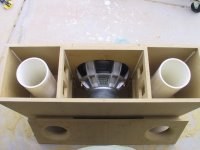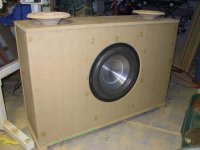I finally got the thing running today, after non-stop issues with circuitry, ground hums, etc. Unassisted, the sub sounds great to me, though I have minimal power I think, an NAD 208 bridged into the parallel VC's, I think it's like 1 ohm the amp sees. That would explain why it fell off line on test tones around 24 HZ.
No stuffing, no lining, and unsealed, it has minimum excursion at 22-23 HZ.
The driver fires into the sofa. Definately effective, not sure if it feels natural.
I'll program the BFD after plotting some test tones. But definate conclusion, we'll be finishing this one.
Should I rewire the VC's in series, and keep the AMP bridged, or keep the parallel VC's and run one channel unbridged?
No stuffing, no lining, and unsealed, it has minimum excursion at 22-23 HZ.
The driver fires into the sofa. Definately effective, not sure if it feels natural.
I'll program the BFD after plotting some test tones. But definate conclusion, we'll be finishing this one.
Should I rewire the VC's in series, and keep the AMP bridged, or keep the parallel VC's and run one channel unbridged?
I'd leave the amp in stereo mode and run each channel to a separate voice coil, unless the amp can handle a 2ohm mono load. My Audio Control amp three worked that way fine even though it wasn't rated for 2 ohm loads, anyway be careful it could do damage if your amp doesn’t have some protection circuit.
Kingdaddy, I'll have to drill extra terminals to do the stereo VC's. I don't see how I can get a 2 Ohm mono load, unless I run one channel (1.5 Ohm). Each VC is approx 3+ Ohm. I'm not concerned with the amp, it has a hearty reputation and soft clipping feature. But bridging (series VC's) for a 3 Ohm load would seem the best compromise of performance and protection.
ThomasW, I really did not know the implications of the backwave, I will line this eventually. Felt on the back wall is a fine idea. After playing with test tones some more, I am not sure of the tuning, actually I'm confused. I thought originally it was 22-23. Now I'm not sure. For grins, I pulled out the inner pipes ( simulating a grossly underdamped alignment) and ran the tones, and I got 30, no motion and almost silent (coincidentally this is also Fs, am I missing something?). I put the pipes back together and it now feels tuned higher than 23.
Besides testing minimum excursion with a finger, is there another method that is easy? This is my first ported design, a novice. Anyway, I planned on some stuffing to bring tuning down a bit, experiments for later.
ThomasW, I really did not know the implications of the backwave, I will line this eventually. Felt on the back wall is a fine idea. After playing with test tones some more, I am not sure of the tuning, actually I'm confused. I thought originally it was 22-23. Now I'm not sure. For grins, I pulled out the inner pipes ( simulating a grossly underdamped alignment) and ran the tones, and I got 30, no motion and almost silent (coincidentally this is also Fs, am I missing something?). I put the pipes back together and it now feels tuned higher than 23.
Besides testing minimum excursion with a finger, is there another method that is easy? This is my first ported design, a novice. Anyway, I planned on some stuffing to bring tuning down a bit, experiments for later.
The test tone method with your finger on the cone IMO is by far the best and easiest way to determine the enclosure Fb. I did this with my latest sub project and it worked flawlessly, my WinISD projected port length was a few inches off (2Hz) and as far as I know no simulation program is dead accurate on port length, so I cut the port longer than needed then used the test tone method to tune it in to my target Fb (20Hz) by cutting a inch at a time off the port length. However when I added the port valve assembly it moved the Fb down about 1.5Hz so it’s now at 18.5 Hz which is fine. If your getting almost no output below Fb then there is something wrong, you should get a lot of cone movement at 1 Hz above and below the Fb, and depending on the room you should get good output ½ octave below the Fb, well, at least mine did.
Well for all intents and purposes it's identical to the front wave.ThomasW, I really did not know the implications of the backwave
If you look at most speaker designs you'll see that they are much deeper than they are wide. This is to keep the rearwave from bouncing off back wall and moving foreward.
Your design will create a very high presssure zone behind the woofer. This will interfer with the proper operation of the woofer.
You probably shouldn't wire the VC's of a HE-15 in series (the resulting inductance will be sky high). Run them in parallel if the amp is up to it, or better yet wire them separately to a stereo amp.
The easiest way to accurately test port tuning is use the following method. Note, I'm cutting the text from a different forum where I posted it.
To check the port tuning you need a digital multi-meter, an amp, a tone generator, and a 100 ohm 20 watt power resistor.
Put the resistor in series with the + lead going from the amp to the woofer. Wire the negative lead as usual.
Now send 50Hz sine wave into the speaker at low volume. Then with the meter set on "volts AC", measure across the +/- terminals of the woofer. Set the output from the amp so the meter reads between 1&2 volts.
Now lower the frequency in steps 5Hz at a time. Each time write down the reading from the meter. As you go down in frequency there will be a point where the voltage bottoms, then starts back up again with the next lower frequency. The lowest meter reading is the port tuning frequency.
For example:
50Hz-1.2V
45Hz 1.3V
40HZ 1.2V
35Hz-1.1V
30Hz-1.0V
25Hz-.75V
20Hz-.5V
15Hz-.75V
10Hz-1.1V
Here the port tuning is 20Hz. That's where the meter reading shows the lowest voltage.
Obviously you can use steps smaller than 5Hz for greater accuracy.
If you need a tone generator and have a computer close to the amp. You can use the output of the soundcard to make the tones Do a google search for "NCH tone generator" without the quotes. This is a great little freeware program.
Thanks for this information ThomasW. While you were typing I was doing some SPL's.
Radio Shack digital readout meter c-weight, fast. 2 ft from the driver in the listening room, sorry I don't have any equipment outside for anechoic.
Please interpret this for me. What is happening at 29 (driver Fs)?
HZ SPL
20 92
21 92
22 93
23 96
24 97
25 97
26 99
27 99
28 97
29 80 just dies, almost no excursion
30 86
31 88
32 85
33 82
34 76
35 85
36 91
37 92
38 94
39
40 95
41
42 90
43
44 93
45
46 100
47
48
49
50 107
55 102
60 97
65 78
70 95
75 96
80 96
85 98
90 98
Radio Shack digital readout meter c-weight, fast. 2 ft from the driver in the listening room, sorry I don't have any equipment outside for anechoic.
Please interpret this for me. What is happening at 29 (driver Fs)?
HZ SPL
20 92
21 92
22 93
23 96
24 97
25 97
26 99
27 99
28 97
29 80 just dies, almost no excursion
30 86
31 88
32 85
33 82
34 76
35 85
36 91
37 92
38 94
39
40 95
41
42 90
43
44 93
45
46 100
47
48
49
50 107
55 102
60 97
65 78
70 95
75 96
80 96
85 98
90 98
Hope you are using the corrections for the RS meter.
First thing to do is to move the sub and remeasure. Comparing the results should make it easy to identify room issues vs problems with the sub itself.
Note that 2' is a weird distance. Use nearfeld, (basically RS meter at the dust cap) or 1m. Also do a nearfield measurement of the output from one of the ports.
If you have the gear to do the measurement as I suggested, see what tuning you actually have....
First thing to do is to move the sub and remeasure. Comparing the results should make it easy to identify room issues vs problems with the sub itself.
Note that 2' is a weird distance. Use nearfeld, (basically RS meter at the dust cap) or 1m. Also do a nearfield measurement of the output from one of the ports.
If you have the gear to do the measurement as I suggested, see what tuning you actually have....
Trick question? Define 'affordable'.....ThomasW, what are the usual suspects for affordable 1-2 Ohm power, 1000W RMS
Paralleled HE-15's are nasty load for a low buck amp.
I drive mine with a Aragon 8008. The power supply is stout enough to output 1000watts stereo into a 2 ohm load. You could fry an egg at full chat, but that doesn't happen frequently. Also Aragon's are designed to deal with heat given their class "A" bias. 8008's are frequently available for $12-1300 on Audiogon
My friend and co-designer JonMarsh, was directly involved with the development of the Crown "K" series. We know they'll do the job, but again not exactly cheap. There are suppliers that will sell the K-2 for ~$1250 depending on how you tighten the thumb screws.......
There are some new really low buck amps from Behringer. The 2500 (~$300) is getting good reviews from a few users (primarily Adire Tumult owners). These are so new that long term reliability is a complete unknown.
Personally I don't trust the low buck Crown/QSC/Ashley/etc for a EQ'd HE-15. IMO there's just something suspect about a 25lb amp that claims to deliver a couple of kilowatts.
Note that any of the switching amps excepting the K-1&2 wil be fan cooled.
- Status
- This old topic is closed. If you want to reopen this topic, contact a moderator using the "Report Post" button.
- Home
- Loudspeakers
- Multi-Way
- EBS: Powerport application





